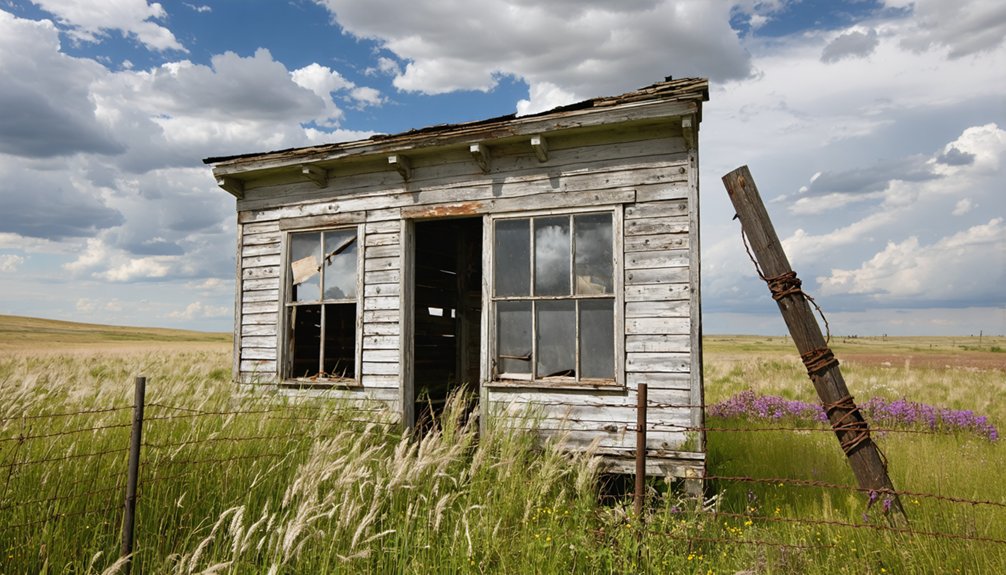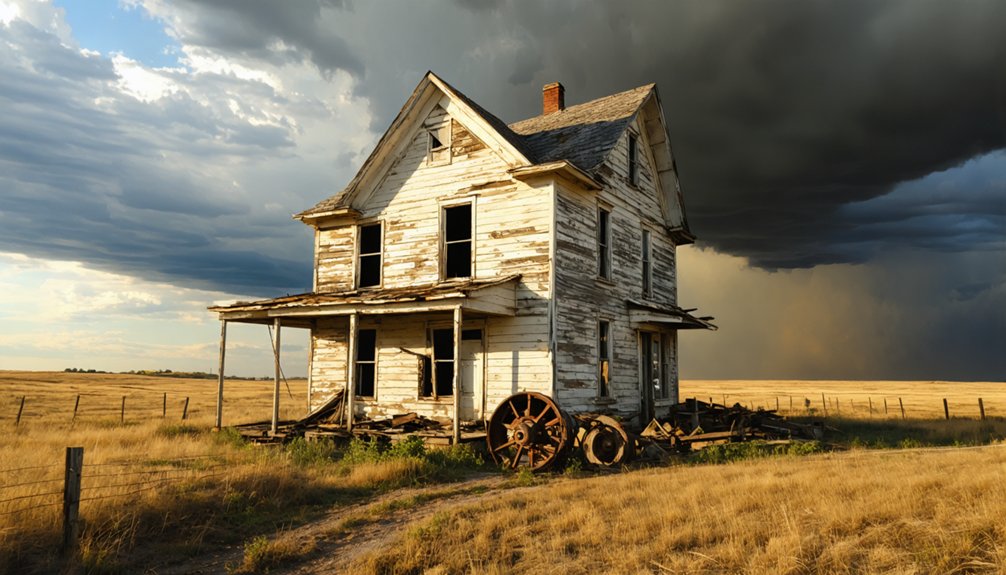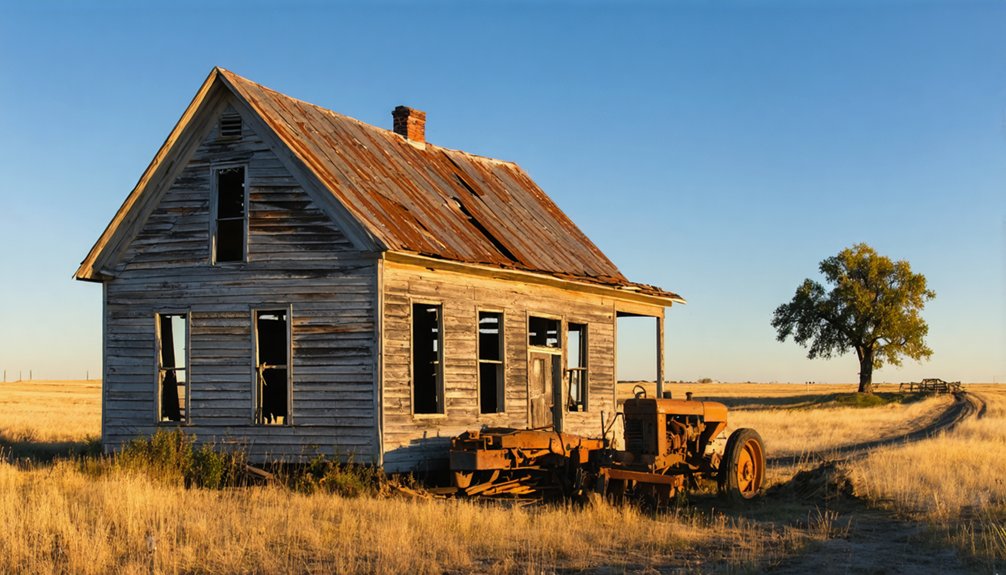You’ll find Bangor’s ghost town site on open pastureland in Walworth County, South Dakota, where this once-prominent settlement served as the county seat from 1884 to 1909. Under Newton Kingman’s leadership and with the Blue Blanket newspaper’s influence, Bangor thrived until the Milwaukee Railroad bypassed it in 1900. After losing a political battle with Selby for county seat status, Bangor declined completely – today, no structures remain to mark its fascinating frontier legacy.
Key Takeaways
- Bangor was a former county seat of Walworth County, South Dakota that now exists only as open pastureland with no remaining structures.
- The town’s decline began when the Milwaukee Railroad bypassed it in 1900, redirecting vital commerce and shipping opportunities elsewhere.
- Bangor lost its county seat status to Selby in 1909, marking the final chapter in its political and economic decline.
- Before its abandonment, Bangor featured a thriving business district with general stores, grain elevators, and banking services.
- The site is now completely vacant, with no historical markers or tourist amenities to commemorate its significance in South Dakota’s development.
The Rise of a County Seat
When Walworth County was organized in 1883, its early years witnessed a series of pivotal changes in county seat designation. You’ll find that Scranton initially held this honor, but by 1884, Bangor emerged as the new administrative center through strategic local leadership. Bangor maintained its status as county seat until 1909 to Selby.
Newton Kingman, who settled in the area after being charmed by the prairie grass, became a prominent figure in Bangor’s development and leadership. Bangor’s county seat dynamics were shaped by ambitious planning and civic development. The town’s leaders positioned it near the center of anticipated railroad expansion, while establishing essential services like postal operations, banking, and real estate.
You’ll appreciate how The Blue Blanket newspaper helped forge the town’s identity and prominence. This period of administrative shifts showcased Bangor’s brief but significant role as a hub of local governance, flourishing under the promise of becoming a major railroad connection point in Dakota Territory.
Life in Early Bangor
In early Bangor, you’d find county operations centered around a small but growing business district where local leaders often served multiple roles as postmasters, bankers, and civic administrators.
Similar to how lumber barons established themselves in other frontier towns, pioneer merchants would establish essential services like general stores and basic postal facilities, creating the foundation for a frontier economy based largely on agricultural trade and basic goods.
These establishments followed the pattern of fur trading posts that had dominated the Dakota Territory economy in the 1830s.
Your social life would have revolved around community gatherings at these commercial establishments, where settlers exchanged news and conducted both official county business and informal trading.
County Seat Daily Operations
During its tenure as Walworth County’s seat from 1884 to 1908, Bangor buzzed with administrative activity centered around its courthouse block.
You’d find county officials managing daily courthouse functions, from processing legal records to overseeing land disputes and criminal trials. The courthouse served as the nucleus of local governance, where tax collection, infrastructure decisions, and policy enforcement shaped the community’s development.
The earliest proceedings took place at Antoine LeBeau’s residence before the courthouse was established.
Key elements of Bangor’s county operations included:
- Judicial proceedings and record-keeping managed by clerks and legal staff
- Mail services through the local post office, connecting citizens to broader networks
- Community gatherings for town meetings and elections within courthouse facilities
The cedar-lined courthouse square symbolized Bangor’s brief but significant role in Walworth County’s early governance before operations moved to Selby. The town’s decline accelerated after the Milwaukee Railroad extension bypassed Bangor in favor of Selby in 1899.
Pioneer Business Community Growth
As pioneer settlers established roots in Bangor, a vibrant business community emerged to serve the growing population’s needs.
You’d find general stores stocking daily necessities alongside enterprising merchants who wore multiple hats – serving as bankers, realtors, and postmasters. This pioneer entrepreneurship reflected the town’s frontier spirit, while The Blue Blanket newspaper kept residents informed of local commerce.
Trade diversification centered heavily on agricultural support, with blacksmiths, feed stores, and equipment repair shops springing up to serve the influx of post-Civil War homesteaders. The growing community mirrored the territory’s explosive growth from 80,000 to 325,000 settlers between 1878 and 1887.
You’d see grain elevators and livestock-related businesses meeting farmers’ needs, while merchants positioned their establishments near government trails for ideal access.
Banking services provided crucial credit to support this growing commercial ecosystem, until the Milwaukee Railroad‘s fateful bypass in 1900 redirected trade elsewhere.
Early Social Life Activities
Life in early Bangor centered around vibrant community spaces where commerce and social bonds intertwined. You’d find the church and school buildings serving multiple purposes, hosting everything from educational lectures to theatrical performances. Like many other Black Hills settlements, the town’s early development was shaped by the economic opportunities of the region. Similar to White Rock, the town’s railroad connection proved vital for bringing visitors and goods to the community.
The I.O.O.F. lodge hall became a cornerstone for social gatherings and community events, while the general store and post office buzzed with daily interactions and news exchanges.
- Community celebrations included seasonal fairs, dances, and picnics where you could trade goods and share local traditions.
- Home-based activities like quilting bees and musical evenings kept settlers connected despite rural distances.
- Traveling entertainers and political speakers brought cultural enrichment and broader perspectives to town gatherings.
These social connections formed the foundation of Bangor’s pioneer spirit, weaving together education, entertainment, and civic engagement.
Railroad’s Influence on Town Destiny
Before the railroad’s arrival, Bangor enjoyed life as a small but established community with promise for future growth.
This was a stark contrast to the successful railroad developments seen in places like Bangor, Maine, where the first train ran in 1836.
You’ll find that everything changed when the Milwaukee Railroad made its fateful decision in 1900 to place its tracks four miles north of the town, effectively cutting off Bangor from essential transportation and commerce routes.
Your understanding of Bangor’s destiny becomes clear as economic and political power shifted northward to rail-connected towns, leaving Bangor to face an inevitable decline that would eventually lead to its ghost town status.
Life Before Rail Access
During the years preceding railroad access, Bangor’s economic and social conditions mirrored those of many isolated frontier settlements across South Dakota.
Farm life centered around subsistence agriculture, with families working tirelessly to produce enough for their own needs while facing significant community challenges in reaching external markets.
You’d have found three primary obstacles that defined daily existence:
- Transportation relied heavily on horse-drawn wagons maneuvering rough, undeveloped roads that turned treacherous during extreme weather.
- Communication with the outside world moved at a snail’s pace, dependent on sporadic mail delivery by stagecoach.
- Limited economic opportunities existed beyond local trade, as geographic isolation and poor infrastructure restricted access to larger markets.
Local residents banded together, building basic roads and bridges while petitioning railroad companies to reflect on their town for future rail lines.
Fatal Route Selection Process
Bangor’s destiny took a devastating turn in 1900 when Milwaukee Railroad officials selected a mainline route that bypassed the town by four miles to the north. This fateful route selection effectively cut off Bangor’s economic lifeline, setting in motion the town’s eventual demise.
Railroad decisions carried immense weight in shaping community futures, and the Milwaukee Railroad’s choice to position their east-west mainline through the county center dealt Bangor a fatal blow.
You can trace the town’s rapid decline through the subsequent relocation of the county seat to Selby by 1908. While Selby flourished with its new courthouse and rail access, Bangor faded into obscurity.
Today, only cedar trees and historical markers near Selby’s courthouse stand as silent witnesses to Bangor’s lost prominence.
Economic Power Shifts North
The Milwaukee Railroad’s 1900 route selection released a dramatic northward power shift that reshaped Walworth County’s economic landscape.
You can see how the area’s economic changes unfolded rapidly as commercial activities migrated four miles north of Bangor’s original location. The population migrations that followed left Bangor increasingly isolated from crucial trade networks and administrative functions.
Key changes that sealed Bangor’s fate:
- Loss of direct railroad access redirected commerce and shipping opportunities away from the town.
- County seat status transferred to Selby by 1908, taking the courthouse and official records.
- Essential grain shipping and market connections moved north, leaving Bangor without its economic lifeline.
Today, you’ll find just a marker south of Selby where this once-promising town stood, evidence to how railroad decisions could make or break frontier communities.
The Battle Between Bangor and Selby
Throughout South Dakota’s early settlement period, a dramatic political tug-of-war unfolded between two ambitious Walworth County towns vying for county seat status. The disputed governance between Bangor and Selby lasted over two decades, with control shifting multiple times.
You’ll find that Bangor initially held the seat from 1884 to 1904, having claimed it from Scranton. Selby then briefly secured it for a year before Bangor regained control from 1905 to 1909.
The historical significance of this battle culminated when Selby permanently won the seat, solidified by the construction of a new brick courthouse in 1911. By 1908, the courthouse records had already moved north to Selby, marking a definitive end to Bangor’s political influence in the region.
What Remains Today

Visiting Bangor today, you’ll find virtually no trace of the once-thriving town that fought so fiercely for county seat status. The site has completely reverted to open pastureland, with vegetation obscuring any historical town remnants or former street patterns.
Unlike other ghost towns that maintain some architectural heritage, Bangor’s historical significance exists only in memory.
- No structures remain standing – all buildings, from churches to businesses, have vanished entirely.
- The land has returned to its natural state, with no visible foundations or recognizable town boundaries.
- Failed preservation attempts have left the area without any tourist amenities or historical markers.
You won’t find any residents, infrastructure, or maintained roads.
Past efforts to transform the site into a living ghost town museum have collapsed, leaving Bangor truly abandoned.
Legacy in South Dakota History
Bangor’s rise and fall exemplifies a pivotal chapter in South Dakota’s development, particularly in showing how railroad decisions and county seat rivalries shaped the state’s settlement patterns.
You’ll find Bangor’s legacy deeply woven into South Dakota’s historical fabric, representing a broader narrative of how transportation infrastructure determined community survival in the early 1900s.
The town’s historical significance extends beyond its physical remains.
Through John Hirning’s multiple civic roles and the town’s brief prominence as Walworth County’s administrative center, Bangor illuminates the complex dynamics of frontier governance.
Bangor’s civic leadership and county seat status revealed how frontier communities established and maintained local government systems.
Today, you can trace its influence in Selby’s courthouse, where transplanted cedar trees stand as silent witnesses to Bangor’s former status.
The town’s story continues to inform our understanding of settlement patterns and administrative evolution in South Dakota.
Ghost Town Tourism and Preservation

While many ghost towns across South Dakota have faded into obscurity, they’ve become increasingly popular destinations for heritage tourism and historical exploration.
Ghost town preservation faces significant challenges, including limited funding and the natural deterioration of remaining structures. You’ll find that these historic sites offer unique glimpses into South Dakota’s frontier heritage, particularly through mining, lumber, and railroad history.
To make the most of your ghost town visit:
- Join guided tours that provide historical context while protecting fragile ruins
- Follow designated trails and markers, like the Michelson Trail, for safe exploration
- Support local preservation efforts through tourism-related spending in nearby communities
These sites serve as open-air museums, helping you connect with South Dakota’s past while contributing to their ongoing preservation through responsible tourism.
Frequently Asked Questions
What Indigenous Tribes Lived in the Bangor Area Before Settlement?
You’d find the region’s Native tribes included Dakota Sioux, particularly the Yankton and Yanktonai peoples, who cherished their cultural heritage there, while earlier Mandan and Arikara communities also called these lands home.
How Many People Lived in Bangor at Its Peak Population?
Based on the available historical records, you won’t find a documented peak population for this town. Its historical significance remains unclear due to missing demographic data from that period.
Were There Any Famous Outlaws or Notable Crimes in Bangor?
You won’t find any outlaw legends or documented crime history here. Historical records don’t mention any famous outlaws or notable criminal activity in this settlement’s brief existence.
Did Any Significant Natural Disasters Affect Bangor’s Development?
You won’t find records of flood impact or fire hazards affecting Bangor’s development. The town’s decline was driven by human decisions, particularly the railroad’s rerouting and county seat relocation in 1908.
What Happened to the Original Buildings That Weren’t Moved to Selby?
You’d weep at this preservation nightmare – the abandoned structures were left to decay as nature took its course through windstorms, lightning strikes, and relentless freeze-thaw cycles until they crumbled into ruins.
References
- https://www.sdpb.org/rural-life-and-history/2023-08-21/some-black-hills-ghost-towns-and-their-origins
- https://www.youtube.com/watch?v=Glucs_Rq8Xs
- https://kxrb.com/bangor-maine-is-famous-bangor-south-dakota-not-so-much-lets-take-a-road-trip/
- https://www.youtube.com/watch?v=yVWWqwcGTt0
- https://www.southdakotamagazine.com/walworth-county
- https://aberdeenmag.com/2019/01/the-ghost-towns-of-brown-county/
- https://en.wikipedia.org/wiki/List_of_ghost_towns_in_South_Dakota
- https://www.hmdb.org/m.asp?m=190167
- https://uscountyhistorybooksdirectoryandlookup.com/states/sd/walworth-county-history/
- https://courthouses.co/us-states/o-u/south-dakota/walworth-county/



